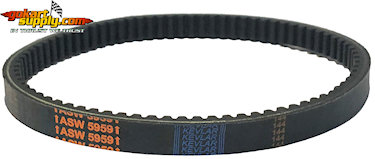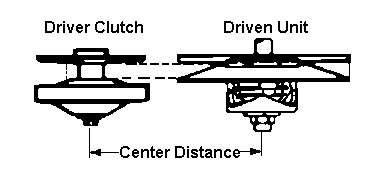
|
 |
|
ASW 5959 Belt $28.50 : This is a Genuine 5959 Belt. The 5959 Belt is a Custom Length, Manco / American Sportworks Factory Belt. It's an Asymmetric, 3/4" Top Width Belt Marked Manco 5959 or ASW 5959. Outer Circumference: 28-1/4". It's longer than the Comet 203589A Belt. Installs with the Flat Side Towards the Engine.
 | ||||||||||||||||
| ||||||||||||||||

These 5959 Belts can also be used on any type of machine that has an asymmetric torque converter with a 6" outer diameter driven pulley and a 6-15/16" to 7" center distance.
If you'd like to use an American Comet Brand Belt instead of the 5959 Belt from India, you can, as long as your center distance is less than 7" and you have a 6" OD driven pulley, you can use Comet Belt #203589A. The 203589A is alittle shorter than the 5959.
Installation: Remove the bolt and any keepers from the end of the engine crankshaft and take the outer half of the clutch off. Clean the clutch. Install the belt with the flat side towards the engine, on the bronze bushing. Make sure both components are perfectly aligned, flat washers and shims are used as spacers. Do whatever it takes to align both sprockets so the chain will stay on, and both components so the side of the belt won't wear down prematurely and litter the system with belt debris.
If you can install the belt without taking the clutch apart, the belt is too long.
If the system is 'eating belts' do not install a new belt until the problem has been corrected. A damaged belt is the symptom of another problem.
Inspect the driven pulley, the larger of the two components. Make sure that all six of the plastic insert buttons are in place. You can see them without taking the pulley apart. If any of the buttons come out, you'll see a hole where the button used to be. Don't run the system if any of the buttons are missing. Missing buttons will allow the driven pulley to open too far. The belt is then able to fall down into an area of the pulley where rivets are present. The rivets will destroy the belt. The insert buttons also keep the movable sheave from spinning, they reduce friction between the cam and the movable sheave and they prevent metal to metal contact thus acting as shock absorbers. The buttons play a very important role in the performance of a torque converter system. If you do have to replace the buttons, glue them into place with contact cement or a similar product.
If you need a longer or shorter Asymmetric Belt that's flat on the engine side, we have them. See the 3/4" Top Width, Comet 30 Series Asymmetric Belts for Center Distances that range from 6-5/8" to 13-1/8". Some machines may require a different length belt if the original engine has been replaced, which usually changes the center distance, or if the 6" driven pulley has been replaced with a 7" driven pulley.
Erratic Engagement is most often caused by the driver clutch that is mounted on the engine crankshaft. The flyweights in the clutch are sticking or the movable sheave is binding on the hub. Knowing how they work may help you determine why yours doesn't. As engine rpm increases, the flyweights push against the outer drum and force the movable sheave (pulley face) toward the engine causing the belt to travel at a greater circumference around the driver clutch. This action in turn causes the belt to force open the driven pulley, allowing the belt to travel at a lesser circumference around the driven pulley.
As engine rpm decreases, the spring in the driven pulley closes the pulley forcing the belt to a greater circumference. This action overcomes the force of the flyweights against the movable sheave and causes the driver clutch pulley to open, allowing the belt to travel a lesser circumference around the driver clutch.
When the engine is at idle, the driver clutch pulley should not engage the sides of the belt. The belt should be loose in the pulley and resting on the bronze bushing around the hub. The bronze bushing serves to protect the belt from rubbing against the spinning hub at idle and also to support a portion of the movable sheave as the sheave moves toward the engine during engagement.
The movable sheave must be able to slide freely on the splined hub without binding. Disassemble the driver clutch and clean away any dirt or lubricant residue using an automotive parts cleaning solvent. Do not use a petroleum based lubricant inside the driver clutch or between the hub and movable sheave. Use a dry, molybdenum based lubricant. The extreme heat and pressure inside the driver clutch chars most petroleum based lubricants. Petroleum based lube also collects dirt which causes increased wear. Graphite lube is better than petroleum lube, but it also eventually leaves a residue that builds up on the parts, causing them to bind and require more frequent cleaning. Experience has taught us that Comet Torque Converter Lube works best.
These belts are not elastic and should not be viewed as a rubber band. With the sophistication of drive belts and drive systems found in today's machines, the drive belt can do much damage to the entire system if the proper belt is not used or if the drive system is not properly aligned and adjusted. In earlier years, the drive system was considered a part of the machine that merely blew alot of belts. Many belts then were of the variety that if the drive system was not properly aligned and adjusted the belt would stretch and in most cases disintegrate before doing much damage to the clutch or driven pulley unit. Today, however, emphasize belt and drive systems have attained such sophistication that if the drive system is not properly aligned or adjusted, or if the wrong belt is used, the belt may tear up the drive system before stretching or breaking. For that reason alone, and to eliminate the expense, trouble and possible safety hazard of blown belts or damaged clutches, the drive system on your vehicle should be given extra care to be sure it's operating properly. Basic guidelines are that the belt be checked periodically for uneven wear. If any irregularities appear in the system or on the belt, it should be serviced.
Go Karts and Large Mini Bikes with rear tires taller than 15 inches require a Torque Converter with a belt and a chain.
Our shop opened in Shreveport, Louisiana in July of 1982. We became a Manco Dealer in 1990, and went online in 1997. We offer Free Tech Support Monday through Friday from 9am to 5pm central. Manco and American Sportworks Go Karts have a model number sticker, on the floorpan, in front of the seat. Model information always helps.
![]()
Page Last Updated: 04/15/2025
© 1997-2025 Go Kart Supply, Inc